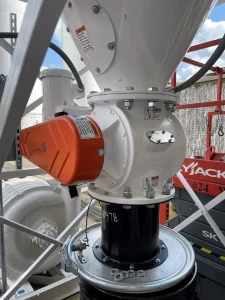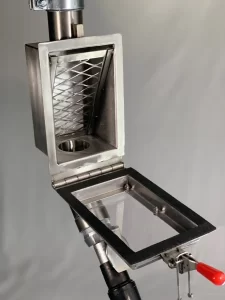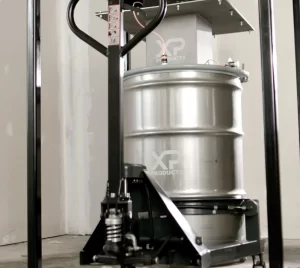Why use an airlock on a central vacuum system.
 A basic central vacuum system can collect to a 55-gallon or 30-gallon drum. However not all facilities have a good method to empty the drum when it is a full. A full drum of dust can be heavy and challenging to empty with out the proper material handling system. In may facilities it is easier to collect the material in a Gaylord Box, Super Sack bag or tote. These are not vacuum sealed and require a vacuum lock between the filter receiver and the collection container below.
A basic central vacuum system can collect to a 55-gallon or 30-gallon drum. However not all facilities have a good method to empty the drum when it is a full. A full drum of dust can be heavy and challenging to empty with out the proper material handling system. In may facilities it is easier to collect the material in a Gaylord Box, Super Sack bag or tote. These are not vacuum sealed and require a vacuum lock between the filter receiver and the collection container below.
When collecting combustible dust, an isolation point is needed between the receiver and collection container. Should there be an explosion event in the collector, a system should be designed with venting or protection above the airlock. A properly designed airlock acts as an explosion isolation device and protects an operator working under the airlock while removing the drum of collected dust.
An airlock can be used to automatically discharge back into a process or into a dust collection system. This automatic solution is great because there is no need for an operator to empty a collection container. This setup can be used when collection multiple waste streams to a single point.
Challenges of an airlock.
Assuming you have a good central vacuum with good capacity for cleaning, it is common that you will collect debris that is larger than dust that can plug an airlock. Items such as strapping, banding, gloves, splinters from skids, nails, bolts, tools and about anything you can imagine, can be collected by the system, but can jam an airlock.
Solutions with an airlock
 An inlet trap can be installed at the drop point. These devices have a screen that allow the dust to pass through, but nothing larger than the size of the screen. This stops the large debris at the point of collection. A clear view port allows the user to visually see if something is stuck or held in the inlet box. The operator then needs open the access door and clear the oversized materials manually. This trap is also oversized so heavy materials such as nails and bolts will not pass the vertically mounted trap. These work great but add cost to a system with many drop points. These can be installed in areas with expected large debris, but not on the other points. Possibly in the shipping department with a lot of skid and shipping materials, but not in the other process areas.
An inlet trap can be installed at the drop point. These devices have a screen that allow the dust to pass through, but nothing larger than the size of the screen. This stops the large debris at the point of collection. A clear view port allows the user to visually see if something is stuck or held in the inlet box. The operator then needs open the access door and clear the oversized materials manually. This trap is also oversized so heavy materials such as nails and bolts will not pass the vertically mounted trap. These work great but add cost to a system with many drop points. These can be installed in areas with expected large debris, but not on the other points. Possibly in the shipping department with a lot of skid and shipping materials, but not in the other process areas.
An economical alterative to the inlet trap is a hose adapter with a cross hair or modified with a screen. This set up will also capture the large debris, however it is not visibile to the operator. And requires more effort to remove the hose adapter from the hose to clean the collected material.
Similar to the local trap, a larger single trap can be installed just before the filter. This will capture and protect the airlock, but is often out of sight. And would require an operator to clear the trap manually. Legends Equipment is currently doing R&D for alternative designs.
Solutions by replacing the airlock
 The XP Products drum kit is an excellent alternative to an airlock on a system with a 55-Gallon or 30-Gallon drum. The drum kit is designed for handling combustible dust unlike a standard drum kit. Since it is an open throat from the filter to the drum, any collected materials that make it through a hose will be collected in the drum. The system has a drum in place sensor so the system does not operate without a drum in position. It also has a high level sensor to indicate the drum is full and needs to be emptied.
The XP Products drum kit is an excellent alternative to an airlock on a system with a 55-Gallon or 30-Gallon drum. The drum kit is designed for handling combustible dust unlike a standard drum kit. Since it is an open throat from the filter to the drum, any collected materials that make it through a hose will be collected in the drum. The system has a drum in place sensor so the system does not operate without a drum in position. It also has a high level sensor to indicate the drum is full and needs to be emptied.
A double dump valve is typically much better at handling large debris and random objects than an airlocks. Double dump valves tend to cost more than an airlock and are taller, but an acceptable solution on some materials. Considerations of combustible dust should be reviewed when using a double dump valve.
Features to consider
When using an airlock to fill a collection container, we recommend a two level sensor system. One high level sensor below the drum, just above the finger guard. This sensor is an indication that the collection container is full and should be emptied or changed. A second high level sensor is recommended above the airlock. This will indicate if the airlock is jammed or product is bridged above the airlock.
When using an airlock to fill a bulk bag / super sack, we recommend a vent to allow ambient air under the airlock. Without a vent, leakage of negative air will come through the airlock and will suck a well sealed bulk bag closed. Product may push the bag open as it fills, but a filtered vent port will greatly reduce the suction on the bag and improve full bag filling.

